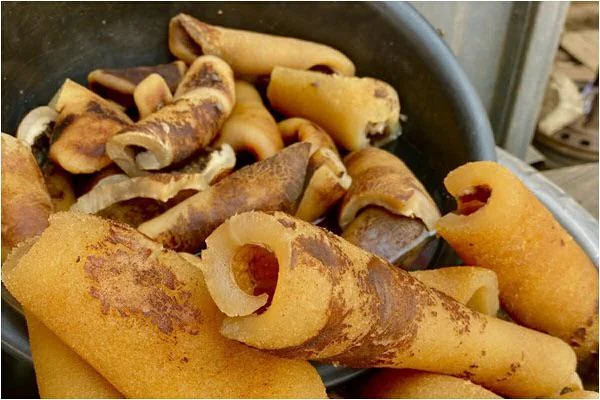Wele: The meat that has no equal
It is one of the meats eaten with strong teeth. Children as well as adults like it in their food. It is called wele. We used to fight over them when we were growing up. I recall that once I almost soiled my uniform as I wrest wele from a friend’s hand during my basic schooldays.
As the African iconic literary giant, Chinua Achebe wrote in his classical “Things Fall Apart: “An old woman is always uneasy when dry bones are mentioned”; wele is age-unfriendly.
One will ask, what is wele? Wele is simply the “Ghanaian” coinage for cowhide which has been processed. Although cowhide is mostly called wele in Ghana; others prefer calling it ‘coat’.
In Nigeria, wele is known as pomo. Wele is eaten throughout the year by those who have strong teeth. People with decayed teeth, schoolchildren and toothless oldies are likely to be exempted from the consumption of wele.
There is no waakye (a Ghanaian local dish prepared from rice, beans and millet leaves) joint that does not add wele in its stew. Wele seems to top the chart of the preferred part of beef. It has “no co-equal”.
Kotokuraba market
Madam Gifty Nyarkoh aka Sister Tawia has been in the wele business for the past 15 years. She plies her trade at the Kotokuraba Market in Cape Coast, Central Region and has several customers. She buys the cowhide from Atonsu in Kumasi, Ashanti Region. She usually buys 100 or 150 cowhides and sells them within a month or in two weeks if she has a good market.
According to her, unprocessed cowhides are brought from Bamako in Mali and wele ‘tycoons’ from neighbouring countries such as Nigeria, Togo, Benin, and Cote d’Ivoire come to Atonsu in Kumasi to buy the hide. She explained that the cowhides from Mali are usually dried for over six months before they are brought to Ghana. She prefers buying the Malian wele because it is easy to preserve, unlike the one from Ghana which is often not well-dried and rots within five days after its been processed. The ones from Mali, however, can stay for more than two weeks without rotting.
She, therefore, appealed to Ghanaian wele processors to adopt good practices that would make their products attractive.
Processing
Ms Nyarko said she usually boils the singed cowhides in a pot for about 30 minutes, after which she washes them with a ‘jeans brush’. She then soaks them in a water basin for one day. She explained that she used the brush because of the car tyres used in singeing the hides. She then cuts the soaked wele into rolls and sells one for GHc2.
Wele consumption affecting the leather industry?
Wele is not enjoyed by Ghanaians alone; it is a delicacy for most Africans. According to an article authored by a Nigerian journalist, Sam Olukoya, in Lagos for the BBC on Tuesday, November 14, 2000, with the headline; “Nigeria eats its shoe leather”, the “skin of animals like cows, sheep and goats, which are needed for the production of goods like shoes, bags and belts, are being eaten at an alarming rate.”
He quoted Dr Samuel Achi, a provost of the Federal College of Chemical and Leather Technology in Nigeria as saying, “The continuous consumption of the pomo means the slow death of the leather industry, which has the potential to yield millions of dollars in revenue annually….These pomo eaters; they have decided to walk bare feet because they have decided to eat their own shoes in their pots.”
Consumers’ views
Ms Sally Ngissah, a reporter, said she used wele for all types of soups apart from light soup. “Anytime I prepare soup, I make sure there is wele in it”, she noted. She could however not tell the nutritional value of wele.
Abdul Rahman Ahmed, a final-year Purchasing and Supply student at the Takoradi Polytechnic, could not hide his passionate desire for wele and Ms Beatrice Abena Quainoo, a National Service person at the Panafest Secretariat in Cape Coast, can be counted among the lovers of wele. When asked for her comments, she said it was delicious when used in soup.
Nutritional value
According to Mrs Sandra Ayisi-Addo, the Senior Nutritionist & Weight Loss Specialist at the Nutriline Company Limited in Accra, cowhide has 20 to 22 per cent protein. She also indicated that it contained important minerals such as iron, manganese, copper and zinc which are needed in the body to promote good health.
According to her, “wele’s protein is however very low in essential amino acids and therefore of low biological value and poor protein quality.”
According to her, wele “must therefore not be eaten as the sole source of protein in a meal”.
Advice on singeing wele
Mrs Ayisi-Addo however stated that, “The singeing process that applies the use of car tyres to remove the fur from cowhide raises some serious health concerns”, and added that “in burning the wele with car tyres, certain poisonous and cancer-causing organic chemicals are released, some of which are absorbed into the wele.”
She therefore advised that safer methods such as soaking the hide in just water to get the fur removed must be generally accepted and enforced to make it safer to consume. She also admonished wele lovers to complement its consumption with other types of protein which have higher biological value.
Who can eat wele?
Mrs Ayisi-Addo noted that wele that had been safely processed could be eaten by everyone. She indicated that “growing children must limit their intake of wele due to its poor protein quality” and added that protein is an important nutrient needed for the growth and repair of worn-out tissues as well as the proper functioning of the immune system.


